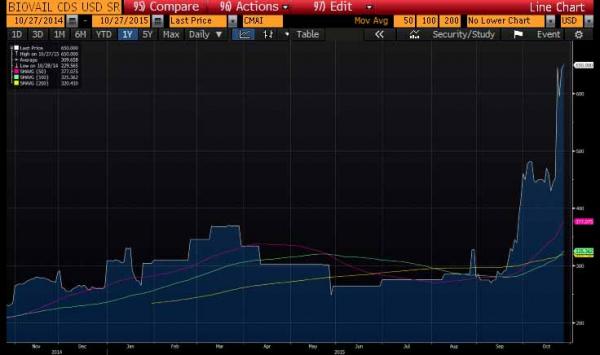While the negative hits to Valeant over the past month have occurred in the equity space, slamming its stock by 50% in the past month, the biggest threat may not be in the equity space at all, but from the bond market.
As a reminder, Valeant – because it is a debt-funded equity rollup – has debt. Lots of debt: over $30 billion at last check on more than 5x less EBITDA. It is also a junk rated company, in fact it is the third largest junk-bond issuer with over $18 billion in sub investment grade securities outstanding.
As such, far more than its debtless biotech peers, it is that much more sensitive to how the market views not only its equity prospects, but also its debt. And, as we first pointed out a month ago, judging by its CDS, the market was getting very concerned even before the recent revelations involving Philidor.
Since then it has only gotten worse, and currently, VRX’ CDS is trading at a spread of 650bps, implying a 43% probability of default.

Moments ago, the BB- rated Valeant debt “story” went from bad to worse, when S&P just revised its outlook to negative citing “Risks To Growth” adding that its “negative rating outlook reflects risks to our base case expectation that Valeant can sustainably grow revenue and EBITDA, given the potential reputational, legal, and regulatory risks the company is facing.“
And now that there is an incremental risk of another downgrade, ostensibly pushing Valeant into the single B category, it will make it that much more complicated for Valeant to pursue its rollups strategy.
In fact, just like Glencore, the upcoming downgrade from S&P now means that the next strategic move from Valeant will not be an acquisition, but most likely some deleveraging divestment to shore up capital, because if and when the downgrade series begins, the company’s debt funding pathway will be promptly closed, leaving only suddenly very risky cash flow as a source of capital.









Leave A Comment